« May 2013 | Main | July 2013 »
June 30, 2013
Coffee Break

Dean Jagger and Myrna Loy in Wings in the Dark (James Flood - 1935)
Posted by Peter Nellhaus at 09:10 AM
June 27, 2013
White Frog

Quentin Lee - 2012
Wolfe Video Region 1 DVD
It's a sign of the times that a film like White Frog is a modestly budgeted independent film rather than a studio production. Even something like Ordinary People would probably not get the green light these days. That the film is available through a niche distributor, Wolfe Video, means that while the coming out story of a gay young man will primarily play for the GLBT audience, there are aspects to the film that might be overlooked.
Not to equate Quentin Lee with Douglas Sirk, at least not yet, but the film shares a view of family life that is similar to be found in films like Imitation of Life and Written on the Wind in which family members are cocooned from life and often each other by money. The title comes from a story about a tadpole stored inside a coconut, growing to become a very edible frog for eating. The analogy is of letting people grow in an open environment, rather than in one of familial or social constraints. While the elder son Chaz can hide his sexual identity, the younger son, Nick, as Asberger's Syndrome, and as such, is unfiltered in how he expresses himself. Both sons have a sense of disconnection from their parents in affluent surroundings. Where Chaz appears to be the perfect son, fulfilling the dreams of his parents, Nick undoes the pair, particularly his father. The parents are wrapped in the illusion of an idealized sense of normality including a picture perfect house that doesn't looked lived in, and social connections that are solely church based. When the parents find out that Chaz was gay, and that he donated time and money to an urban center for GLBT youth, it's not quite like Lana Turner's last reel revelations during Juanita Moore's elaborate funeral, but there's a similar spirit at work here.

While the film touches on divisions based on sexual identity, and to a lesser extent, economic class, race is never an issue. Though never discussed, it is significant that the Asian-American family name is the possibly Anglicized Young. The one time the family is presented eating a dinner with chopsticks, it doesn't take a sharp eye to note that it is of the home delivery kind. One might argue that Lee, and the mother-daughter screenplay authors, Fabienne Wen and Ellie Wen, chose to play down the Asian identity of the characters, although it might also be seen as part of the way the characters would see themselves. While Chaz's identity as gay almost causes a schism between his poker buddies, that one is Jewish, one African-American, and one is of South Asian descent is never remarked upon.
If I am stressing the concept of identity, it is at the core of Quentin Lee's films. The documentary, 0506HK was Lee's look at himself, friends and family members, all of whom have been affected in one way or another as former or current residents of Hong Kong. For someone of Lee's generation, even the country of their birth changed identity from a British colony to part of China, though in a limited sense, independent of the mainland until 2046.
Playwright David Henry Hwang plays a supporting role as the Young's family pastor, and had a hand in shaping the screenplay as script consultant. Where the film is weak is in the casting. As much as it is great that several Asian-American actors have lead roles, only Booboo Stewart and Harry Shum, Jr. as brothers, as Nick and Chaz respectively, were effectively cast. I love Joan Chen and have so since The Last Emperor, but it was hard to see her as married to BD Wong, who always was eclipsed whenever Miss Chen was onscreen. Kelly Hu is quite funny in a brief turn as Chen's sister, reminding Chen that even for relatives, she charges an hourly rate when working on their behalf.

Posted by Peter Nellhaus at 08:00 AM | Comments (2)
June 25, 2013
The Big Circus

Joseph Newman - 1959
Warner Archives DVD
"They're on the brink of disaster,
hearts beat faster,
when they're through."
The lyrics teeter on the edge of self-parody. Considering that the title song for The Big Circus was written by Sammy Fain and Paul Ferris Webster, I have to put it in perspective of their two Oscar winning songs, "Love is a Many Splendored Thing" with its big chorus can in no way be considered understated, while "Secret Love" from Calamity Jane left a door open for other interpretations to the lyrics. The song is no classic, and neither is the movie, not that either get in the way of the fun.
Released seven years after Cecil B. DeMille's The Greatest Show on Earth, and barely disguising any similarity to that film, Joseph Newman's film is actually an improvement. Sure, the budget was smaller, and the stars were culled from the B list, but unlike DeMille's two and half hour slog, this show is lighter by about forty-five minutes. I don't know how much the film cost to produce, but it was successful enough to get producer Irwin Allen back onto the lot of the 20th Century-Fox for the next decade, while Newman closed out his career in theatrical films as house auteur at Allied Artists, for whom this film was made.

This is another case of a DVD rescue allowing me to see a film that I was aware of, but had never seen, from childhood. I have a memory of constant television commercials for The Big Circus. I would have been seven years old at the time. Summer of 1959 at my grandparents house in Detroit. If there was any name among the stars that had any meaning, it would have possibly been Red Buttons. What I do recall is the announcer pronouncing the name of the top billed actor as "Victor Mat-yooooor!".
Anyways, Vic is running a circus that's on the verge of bankruptcy. Red Buttons is the bank's guy who makes sure that their investment in the circus pays off. Red brings along Rhonda Fleming as press agent who challenges Vic's ideas on suitable jobs for women. There's also someone who's trying to sabotage the circus. I won't tell you who, except that it is revealed that prior to joining the circus, he had spent six years in "an institution for the criminally insane". I would guess there was a time when job references weren't always a key to some forms of employment. Best of all is Peter Lorre as Skeeter. Lorre takes on the James Stewart role from The Greatest Show on Earth in the role of an actor who can be easily recognized, even with clown make up. Lorre is the best part of this film, whether dressed as a clown or not, providing wise cracking commentary for most of the action.
Being an Allied Artists' production, the film was shot with an economic visual style of mostly full shots and some medium shots. It's not like Joseph Newman wouldn't have known how to film it any other way, but he uses his budgetary constraints to his advantage. The without using the kind of positioning of actors that might be found in the wide screen works of Nicholas Ray or John Sturges, many of the shots are composed in such a way to see the actors speak or react to each other, without looking "stagy". The result is that the viewer can glance from the banter of Victor Mature and Rhonda Fleming, to the comical poses of Peter Lorre within the frame, rather than cutting between the actors and their particular bits of business. As a former Assistant Director, Joseph Newman would be conscientious of keeping any film production on time and on budget.
The film story was by Irwin Allen, not above plugging one of his earlier productions, when Victor Mature passes a theater marquee showing Allen's documentary, The Sea Around Us. Also credited for the screenplay are Charles Bennett, best known for his writing collaborations with Alfred Hitchcock, and Irving Wallace, his last screenplay before embarking on a career of literary potboilers like The Chapman Report. As the title song suggests, there is a sense throughout the film that everyone knows not to take anything too seriously, all of which adds to the fun.
Posted by Peter Nellhaus at 08:55 AM
June 23, 2013
Coffee Break
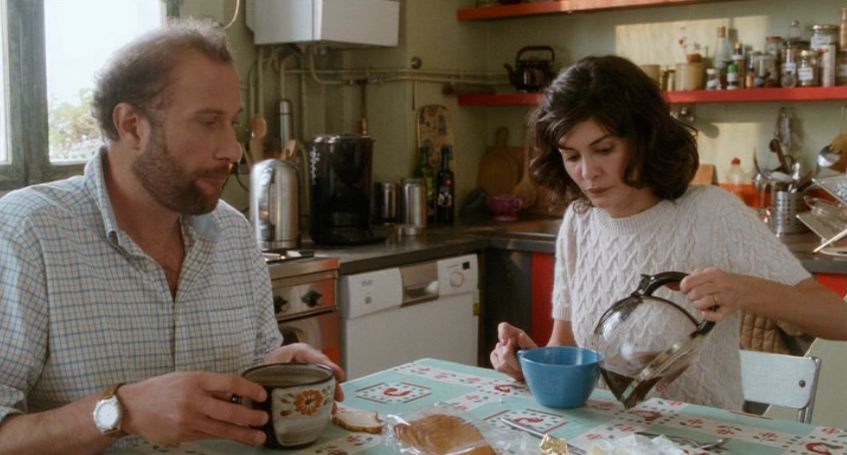
Francois Damiens and Audrey Tautou in Delicacy (David Foenkinos & Stephane Foekinos - 2011)
Posted by Peter Nellhaus at 08:50 AM
June 20, 2013
Tai Chi Hero

Stephen Fung - 2012
Well Go USA Entertainment Region 1 DVD
In between the time I saw Tai Chi Zero and the newly released sequel, I did a little bit of "homework", and caught Stephen Fung's 2005 film, House of Fury. Ideally, I would have seen that film earlier, because it combines martial arts with a whimsical premise on a smaller scale. Anthony Wong plays the practitioner of traditional Chinese medicine, and the source of embarrassment to his image conscious teenage daughter. It turns out Wong is a former government hit man, and the walls and floors of his modest home hide some very elaborate and high tech rooms.
Martial arts and technology are very much at the forefront of Tai Chi Hero. Fung has had the good sense to substantially tone down some of the gimmickry of the first film, though superimposed titles to introduce various guest stars is repeated. The gimmicks here are what have given the series the description as steampunk, in particular the creation of a single manned airplane called Heaven's Wing. There are also a fight scenes and lots of wire work, primarily the work of Sammo Hung, working here as the action director.

The main characters from Tai Chi Zero are back. And this film, like the last, can be interpreted as something of a parable about the westernization of China, and its role on the world stage. Western interests are personified by Peter Stormare as an unscrupulous industrialist named Duke Fleming, with what seems like an unlimited fortune.
The town of Chen is a proxy for the China that barricaded itself from outsiders and outside interests. Lu Chan, the zero turned hero, is still unable to be accepted, even after marriage to the Grandmaster's daughter, Yu Niang. The prodigal son of the Grandmaster, Zai's value is initially based on his martial arts prowess or lack thereof, until he is able to demonstrate what can be done with his interests in mechanical devices. The happy ending gives way to a hint of more to come with Duke Fleming entering a fortress with a skull-like entrance.
Maybe she's be seen more decisively in the third part of this trilogy, but Nikki Hsieh's character should have been more developed. As the deaf-mute wife of Zai, Hsieh appears as nothing more than the pretty wife who stays in the background. There's more than meets the eye when she briefly engages in a rooftop fight with Tony Leung Ka Fai. Hsieh disappears from the film soon after that scene. While it's nice that Stephen Fung has a large budget at his disposal, the best special effect in movies is still an intriguing character on the screen.
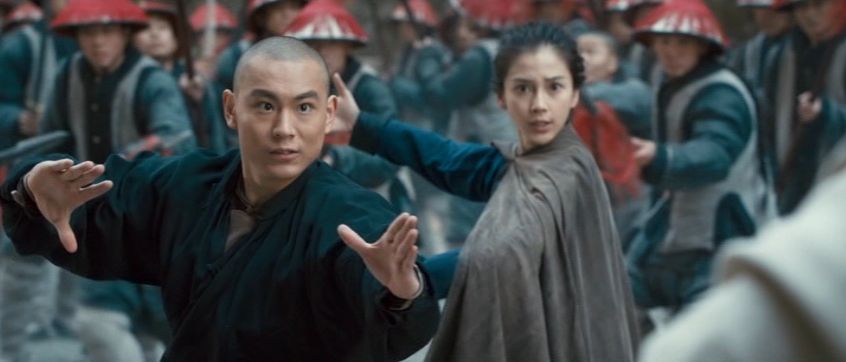
Posted by Peter Nellhaus at 03:13 AM
June 18, 2013
Young Man with a Horn

Dorothy Baker - 1938
New York Review Books Classics
Michael Curtiz - 1950
Warner Brothers Region 1 DVD
Back between 1969 and 1971, Martin Brest and I were both at NYU's film school and the then closed-circuit radio station, WNYU. I was a production assistant on one of Martin's student films, a few months before transferring to the newly created undergrad Cinema Studies program. I was better at writing about movies and learned the hard way that I didn't have the kind of personality to lead a film crew. During this time, Martin Brest and I also had our own little radio shows. I was mostly into relatively obscure rock, culty stuff like Captain Beefheart and his Magic Band, and could count on my friends to call up to request The Masked Marauders' parody of the Rolling Stones, "I Can't get no Nookie". Martin Brest played jazz records. Old jazz from the 20s and 30s. Woody Allen's soundtrack albums before the ever existed. I always thought that if Martin Brest was going to make a movie, it would be "The Bix Beiderbecke Story".
A film that actually was faithful to Dorothy Baker's novel hasn't been made. One thing that jazz writer Gary Gidden's afterword to the nove makes clear is that these are very real songs the characters refer to. The main character of Rick Martin is modeled after Bix Beiderbecke in regards to the music, and for Rick Martin, music, to the disregard of almost everything else, is his life. The other filmmaker who might make a good film would be Spike Lee, the son of a respected musician, Bill Lee, although Lee would probably emphasize the racial aspects of Baker's novel over the music. It would be an oversimplification, but Baker's novel is the opposite of Martin Brest's most popular movie, Beverly Hills Cop. Where the movie is about a lone black man from Detroit navigating his way through a very white and wealthy American suburb, Baker's novel is about a white man who feels most at home in the company of black musicians and their families.
Baker's narrative spends a much greater time on Rick Martin's childhood which takes up about fifteen minutes of screen time. The film has only one significant black character, Martin's musical mentor, Art Hazzard, who has some of the elements of three characters from the novel, Hazard (spelled with one Z), an established jazz band musician, Rick's boyhood friend, Smoke Jordan, and Rick's musical peer, Jeff Williams. Taking place in the 20s and 30s, the novel also reflects racial attitudes of the time, where "coon" is a popular pejorative. In the movie, Smoke is the nickname of a new character, Willie Willoughby, a white pianist who plays with Rick Martin in several bands. Smoke's sister, Jo, is changed to a white band singer, and love interest to Rick Martin. Given the time that the film was made, the deracination of Baker's novel is not surprising, but it also betrays the heart of the book.

Aside from Kirk Douglas and Doris Day performing with a jazz band led by Juano Hernandez, racial matters are at most suggested. In the film, the black musicians only play for a white audience. The novel discusses the parameters of racial discrimination be it in the recording industry or musical styles, as well as whether a racially integrated jazz band could find commercial acceptance. Perhaps most radical of all in the novel is that Rick Martin sometimes indicates that he wishes he were black. Juano Hernandez is a shade to kindly and understanding as the father figure and mentor to Kirk Douglas. The film might be considered a mildly progressive work considering its time and as a product of a major Hollywood studio. To put this in additional context, regarding black in Hollywood movies and Warner Brothers in particular, one has to remember that Chester Himes once had a very brief tenure writing story synopsis until the day Jack Warner found out about his employment, stating, "I don't want no niggers on this lot."
Where the film is more direct than the book is in the character of Amy North. The novel has only the fleeting suggestion that Amy and Jo might be lovers. From the novel, ". . . she sat there, both hands on the table, not moving a muscle. only watching Josephine as if she were a horse she'd just put her last cent on." It is also quite possible that one or both of the film's screenwriters, Carl Foreman and Edmund North, were familiar with Dorothy Baker's novel, Trio. The description of that novel suggests that the lesbian academic, Pauline Maury, is a full blown extension of Amy North, who in the book and novel, is still a student, and still tentative in establishing a sexual identity. What the film can't convey as well is how the relationship between Rick and Amy plays out, with the uneducated and socially awkward Rick who understands the world through instinct, while the well-read and intellectual Amy equally misunderstands the man who becomes her lover as well as husband. That Amy leaves the cuckolded Rick, remarkably for a film of its time, for a woman, makes a pun out of the title.
Not to be misunderstood as I do love this movie, even though I know now that Warner Brothers built up a part for up and coming Doris Day at the expense of Dorothy Baker's story. There's some great shots of Kirk Douglas walking, or later, staggering, through New York City, the real New York City, and not a set. Michael Curtiz was the top house director at Warners, and as far as I'm concerned, this is a better movie than the beloved Casablanca. I won't even begrudge the happy ending, which might appear tacked on to anyone who read the novel. Still, I think a film that more accurately reflects Dorothy Baker's exploration of race and music might be a film worth making.

Posted by Peter Nellhaus at 08:52 AM | Comments (1)
June 16, 2013
Coffee Break

Arnold Schwarzenegger in The Last Stand (Kim -Ji-Woon - 2013)
Posted by Peter Nellhaus at 09:54 AM
June 13, 2013
Kahaani
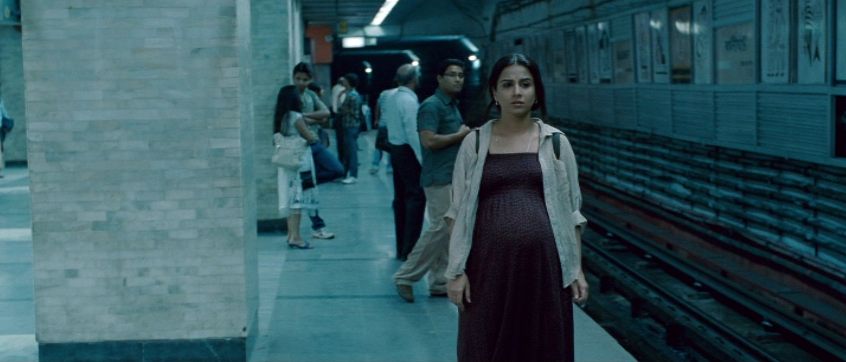
Sujoy Ghosh - 2012
Viacom 18 All Region DVD
I first was aware of Kahaani when I was doing some online research into films outside of Hollywood or Europe that displayed the influence of Alfred Hitchcock. To apply the adjective of "Hitchcockian" to Kahaani would be inaccurate, not the least reason being that it would set up certain unfulfilled expectations. But this is still one very good thriller just the same.
A very pregnant woman, Vidya, flies from London to Kolkata, with a police station as her first stop in that city. Her husband as disappeared, and there are no records of anyone knowing anything about him. A very helpful policeman, known by all as Rana, may have dropped a clue when he mentions that many people is this region of India have two names, their family name, and a "pet" name. A connection is found between Vidya's husband and a man said to be connected with the death by gas of passengers in a subway two years earlier, an incident that seems inspired by the Sarin gas attack in Tokyo in 1995. Government agents get involved as there seems to be much more than a missing husband at stake.
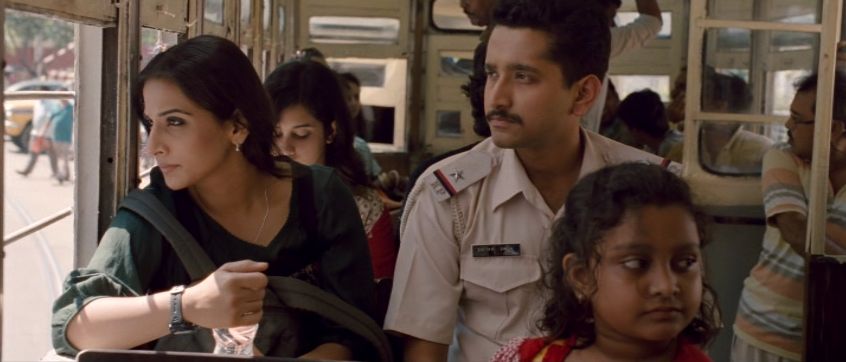
The film pointedly takes place during Durga Puja, allowing both for extra color during the street scenes. More significantly, Vidya is the mother who comes to contemporary Kolkata to uncover and eliminate evil. Also, Vidya proves herself formidable in pursuing the truth about her husband in the face of entirely male opposition.
Duality is emphasized throughout the film. On the lighter side, Vidya is frequently called Bidya. There is also a very courteous hitman, whose daytime job is as Kolkota's worse life insurance salesman. There are also the questions surrounding the identity of Vidya's husband.
Kolkota is something of a major character as well. Sujoy Ghosh breaks away to show street scenes with sidewalk tea cafes and food vendors, a warehouse full of Hindu deities, narrow alleys, and a crowd of women all dressed in red and white saris. Unlike the polished Mumbai of Bollywood films, there's no effort to disguise what appears to be the essential grubbiness of Kolkota, or at least those parts of the city where the film takes place. Contrast is made to the gleaming white, palatial Victoria Monument, seen in the distance. Ghosh's film style is markedly western, with some fast cutting and use of digital effects, as well as incorporating the music as part of the background, yet, unlike some Indian filmmakers, everything is in the service of a very involving story with its share of unexpected twists and turns. The title, in its literal translation means "story", but is without a true English language equivalent, and is suggestive of an Indian narrative tradition of stories within stories.
Made for a relatively low budget, Kahaani was one of Indian cinema's biggest commercial and critical hits of 2012. Aside from star Vidya Balan as the woman in peril, the rest of the cast is of Bengali actors. That it portrays the type of woman uncharacteristic of much of Indian culture can be attributed to Ghosh's collaboration with writer Advaita Kala.
Some thoughts on Kahaani from Girish, as someone who personally knows Kokata.
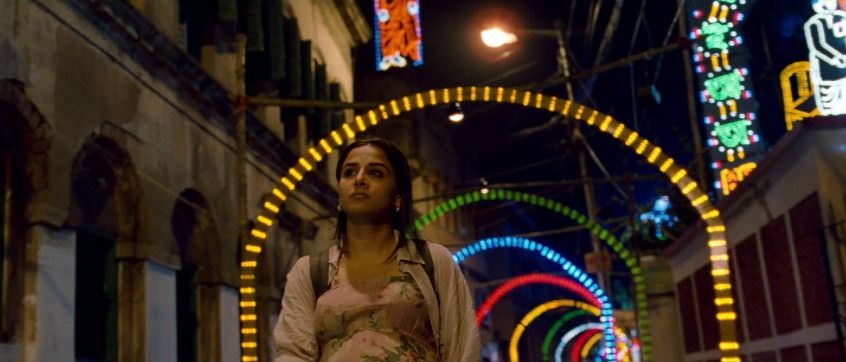
Posted by Peter Nellhaus at 07:43 AM
June 11, 2013
Re-Agitator

Izo
Re-Agitator: A Decade of Writing on Takashi Miike
Tom Mes - 2013
FAB Press
It is an auspicious coincidence that the updated version of the original book coincided with Takashi Miike's having his first film in competition at Cannes, as well as the recent announcement that he would be making his first Hollywood production, The Outsider, produced by Joel Silver, and to star Tom Hardy. Especially as Miike remains highly productive with at least two films a year, some of us may never see anything close to a definitive film by film examination of his work. What Tom Mes has offered is a collection of notes, some which have appeared accompanying the English language DVD releases of Miike's films.
Where the book is most valuable is in helping put a context to Miike's career. Mes discusses some of the best known films, but also those films that are less discussed, as well as the earliest work, films made for Japan's video market that might never be seen by more than the original audience. Also important is positioning Miike within Japan's film industry. Japan is mirroring Hollywood, so it would make sense that some of Miike's most recent films include big budget remakes like 13 Assassins, as well as helming a crime thriller, Shield of Straw for Warner Brothers' Japanese studio. Mes covers the era of the direct to video film, where younger directors had their first opportunities to prove themselves. One such film was Gozu, a film so idiosyncratic that the producers had no intention of having the film be seen outside of Japan, yet it was also Miike's entry to Cannes ten years ago.

The Great Yokai War
One of my favorite chapters is on Imprint, Miike's contribution to the Showtime cable anthology, "Masters of Horror". Like others, I had great anticipation for what would have been one of the more intriguing films in that series, although I sensed that Miike would up the ante for depicting horror in this series. My feelings were confirmed when Showtime chose not to screen Imprint, and when I finally saw the DVD version. Mes tells a story about Showtime and producer Mick Garris being uncertain as to whether Miike would make his film on time and within the allocated budget. Whether one likes or loathes Imprint, the story of the production illustrates the old adage, "Be careful what you wish for . . ".
The people most likely to snap of this book are probably confirmed Miike fans. Those who really need to read this are those critics and film journalists who kept insisting that the forthcoming The Outsider is Miike's English language debut, forgetting about Sukiyaki Western Django from 2007. One of the couple of times that I've been able to see a Miike film theatrically was when Happiness of the Katakuris played in Denver. Nothing could make me more enthusiastic than reading the review of the Denver Post's clueless second string film critic, Michael Booth, who began, "There are so many moments in Happiness of the Katakuris that beg us to walk out on the movie . . .".
Just a couple of small quibbles - Films cashing in on the popularity of musicians has long been a staple of international cinema prior to A Hard Day's Night. The difference is that Richard Lester's film was a significantly greater critical and commercial success than anticipated at the time of filming. Had I not read the chapter on Andromedia, I would have never known that the four young women were members of the quartet called Speed. That the four young men are members of a group, Da Pump, is made clearer with an incongruous hip hop number in the middle of that film.
Miike translator and actor Christian Storm is helpful in his introduction, discussing Miike's working methods on the set, and explaining how certain humorous moments are Miike's way of paying tribute to Shohei Imamura, for whom Miike served as an Assistant Director. Storm explains that similar scenes were Imamura's tribute to the director he served under, Yuzo Kawashima. Surprisingly, Storm doesn't mention how Miike's connection with Imamura has continued with three films, with screenplays by Imamura's son, Daisuke Tengan. Those three films, by the way, are Audition, Imprint, and 13 Assassins.
This is a generously, and beautifully illustrated book, filled with both film stills and original photographs. The filmography lists Miike's features as well as television work, and direct to video films through 2012. Even with the inconsistent availability of Miike's films for an English language audience, this is still a book worth adding to the library.
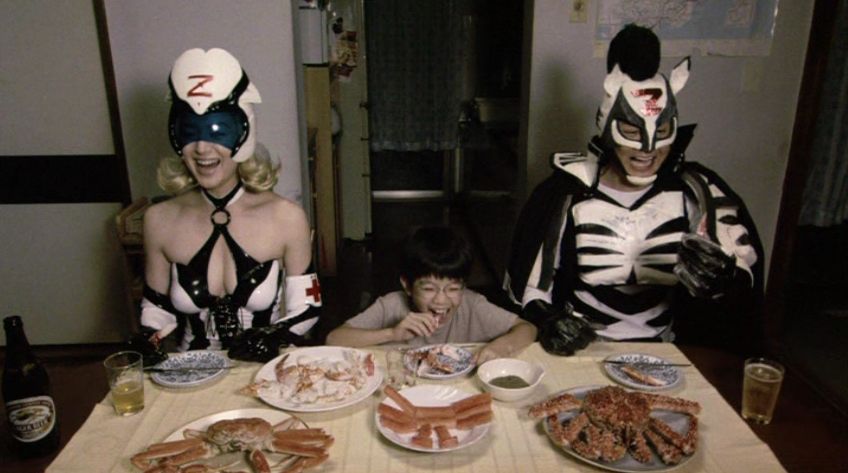
Zebraman
Posted by Peter Nellhaus at 07:28 AM
June 09, 2013
Coffee Break

Mae Clarke in Waterloo Bridge (James Whale - 1931)
Posted by Peter Nellhaus at 09:28 AM
June 06, 2013
Clip
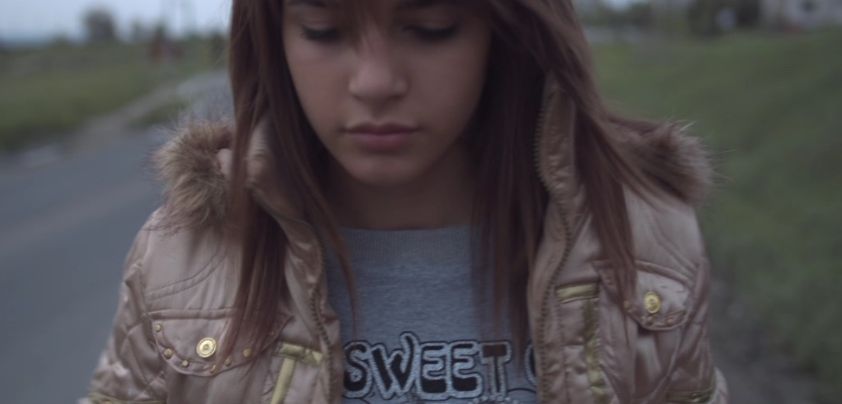
Klip
Maja Milos - 2012
Artsploitation Films All Region DVD
I will try my best here, but if I had my choice, I'd wish that Susan Sontag was writing about Clip. Sontag's long essay, "On Photography" helped me articulate different aspects of photography both in terms of artistic expression as a form of documentation. How this fits in with Clip is that teenage Jasna is constantly filming her life with her cell phone camera, often what might be considered those parts of one's life too personal to be sharing. There is a scene in which Jasna's mother and Jasna's grandparents are looking at old photographs. Photography functions in a more conventional, traditional way, as a visual document of family members and as a means of invoking nostalgia among those who are part of that family. Jasna walks away, wondering why there would be interest in dead people.
The clip referred to in the title is one Jasna made, filming her just shaved vaginal area. The older by a couple of year boy that she pursues, chooses to jerk himself off while watching the clip, while Jasna lies still below him. Throughout the film, emotional connections are filtered through technology, whether by the constant filming of various activities, cell phone conversations, or singing along to pop records. That use of technology is an added twist to the classic elements of teen rebellion and angst: bullying, spontaneous fist fights, drugs and alcohol, trashing school, and exploring sexuality.
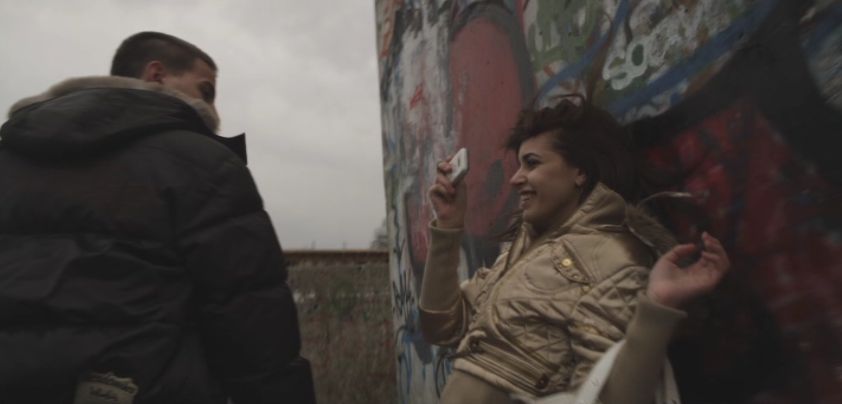
Maja Milos cuts between the observational camera and the footage filmed Jasna's cell phone camera. The value placed on cell phone documentation comes to a head when Jasna visits a facility for abandoned elementary school aged children. Instantly "adopted" by Stana, Stana insists that Jasna film her. The little girl mimics the poses of models and proudly shows off her few possessions. In her own way, Stana acts as both a parody of Jasna as well as a hint of a future dominated by self-absorption and the need to appear on a cell phone camera.
Maja Milos was an assistant director for Life and Death of a Porno Gang, which was reviewed last year. If the more notorious films are any indication, there is a freedom as well as energy expressed by Serbian filmmakers. It might also be worth considering that the country as it currently stands is still young, and that the youth in Milos' film have no personal knowledge of the Yugoslavia of their parents and grandparents.
The Serbian pop and rock songs on the soundtrack emphasize this current era of frankness and open sexuality. One of the nice parts about the subtitling here is that it includes translations of the song lyrics, a practice I wish was to be found on all movies. As such, Clip also serves as an introduction for many viewers to the music known as Turbo Folk. The DVD also includes an interview with Milos discussing the making of the film, and some thoughts on her favorite filmmakers. There is also more in depth analysis in the enclosed booklet, plus an interview with star Isadora Simijonovic, fourteen years old at the time Clip began production.

Maja Milos
Posted by Peter Nellhaus at 08:02 AM
June 04, 2013
Valerie

Gerd Oswald - 1957
MGM Limited Edition DVD
I first became aware of Valerie from the notes on Gerd Oswald in The American Cinema. Andrew Sarris described the film as a "frontier Roshomon". The main differences that such a description does not address is that while the film takes place in and near a fictional town called Limerock not too long after the Civil War, in spite of the film's setting, the film can not truly be considered a western. And unlike Akira Kurosawa's film which centered on one incident seen from the point of view of several people, Oswald's film recounts a series of incidents from the point of view of three people. Setting aside the era in which the film takes place, and the physical setting, Valerie does fit in visually and thematically with Oswald's other film noir work, and is not too removed from his later assignments on the "Perry Mason" television series.
What impresses me most about Valerie is how much information Oswald is able to contain in a single shot, whether it's to convey the relationship between people or even to establish the location of a scene. The mystery of Valerie is first established with a group shot of three men. Two enter a small house. We hear, but do not see, shooting. Only one man emerges from the house. The remainder of the film takes place during the trial of that man, John Garth. The main witnesses are Garth, the town's preacher, Reverend Blake, and Garth's wife, Valerie. Each describe the events that preceded the shooting. Each also gives somewhat different descriptions not only of the events, but of each other. The film might also be read lightly as political allegory as Garth is the home town hero, while Blake and Valerie are both outsiders, both from outside the United States, with Valerie and her parents cited as "foreigners" from an unnamed country.
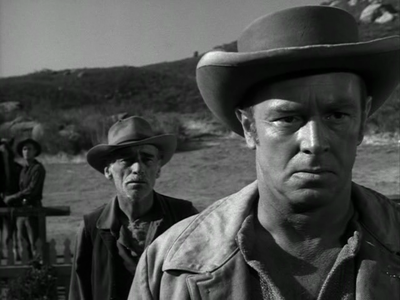
Oswald will shoot two different versions of the same incident in the same way. During the night of Garth's honeymoon with Valerie, the camera is facing the towards Valerie's bedroom. In one flashback, we see Garth helplessly standing outside the bedroom, locked out by his bride. In a similarly filmed flashback of that same night, we see Garth swooping up Valerie against her will, carrying her to the bedroom. In one flashback, Garth holds a gun to Blake, while another version shows no threat of violence by Garth. In other scenes, the dialogue is repeated but in a somewhat different situation than what was seen previously.
How Oswald was chosen to direct Valerie, I do not know. His economical, and visually loaded use of a single shot is also examined by C. Jerry Kutner discussing Screaming Mimi, another film based on personal perceptions and interpretations of past events. What is clear is that even as an assignment, Valerie is not dissimilar to Oswald's other credits beginning with A Kiss Before Dying through Screaming Mimi, with narratives about murder, manipulation of the truth, and the difference between facts and perceptions.
The screenplay is by Leonard Heideman and Emmett Murphy. Certain aspects of Heideman's life read like the plots of Oswald's Fifties movies. Additionally, Heideman's life gives Valerie autobiographical weight regarding the relationship between Garth and Valerie, as if parts of the writer's personal life were played out on the big screen. There is some irony to consider that the part of Garth, who might be considered a proxy for Heideman, was played by the physically imposing Sterling Hayden, while Heideman saw himself in his nightmares as a dwarf. What is certain is that Valerie, along with Gerd Oswald's other films from the Fifties, is worthy of much deeper consideration.

Posted by Peter Nellhaus at 08:46 AM | Comments (2)
June 02, 2013
Coffee Break

Gary Merrill, Catherine McLeod and Joseph Cotten in A Blueprint for Murder (Andrew L. Stone - 1953)
Posted by Peter Nellhaus at 08:01 AM
